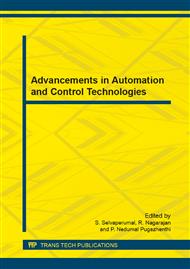[1]
A.E. Diniz, R. Micaroni, Cutting conditions for finish turning process aiming: the use of dry cutting, Int.J. Mac. Tool. Manuf. 42 (2002) 899- 904.
DOI: 10.1016/s0890-6955(02)00028-7
Google Scholar
[2]
G. Boothroyd, W.A. Knight, Fundamentals of machining and machine tools, 03 (2006) 573.
Google Scholar
[3]
Z.W. Zhong, L.P. Khoo, S.T. Han, Prediction of surface roughness of turned surfaces using neural networks, J. Adv. Manuf. Technol. 28 (2006) 688–693.
DOI: 10.1007/s00170-004-2429-4
Google Scholar
[4]
J.A. Baley, S. Jeelani, S.E. Becker, Surface integrity in machining AISI 4340 steel, J. Engg. Ind., 98 (2007) 999- 1007.
DOI: 10.1115/1.3438989
Google Scholar
[5]
E.O. Ezugwu, C.I. Okeke, Tool life and wear mechanisms of TiN coated tools in an intermittent cutting operation, J. Mat. Proc. Tech. 01 (2001) 116: 10–15.
DOI: 10.1016/s0924-0136(01)00852-4
Google Scholar
[6]
M. Nouari, G. List, F. Girot, D. Coupard, Experimental analysis and optimization of tool wear in dry machining of aluminum alloys, Wear, 255 (2003) 1359–1368.
DOI: 10.1016/s0043-1648(03)00105-4
Google Scholar
[7]
R. Jeyapaul, P. Shahabudeen, K. Krishnaiah, Simultaneous optimization of multi-response problems in the Taguchi method using genetic algorithm, Int.J. Adv. Manuf. Tech. 30 (2006) 870: 878.
DOI: 10.1007/s00170-005-0095-9
Google Scholar
[8]
M. Kaladhar, K. Venkata Subbaiah, C. Srinivasa Rao, Performance evaluation of coating materials and process parameters optimization for surface quality during turning of AISI 304 austenitic stainless steel, Int.J. Engg. Sci. Tech. 3 (2011) 89-102.
DOI: 10.4314/ijest.v3i4.68545
Google Scholar
[9]
S. Bharathi Raja, N. Baskar, Optimization techniques for machining operations: a retrospective research based on various mathematical models, Int.J. Adv. Manuf. Tech. 48 (2009) 1075–1090.
DOI: 10.1007/s00170-009-2351-x
Google Scholar
[10]
P.J. Ross, Taguchi Techniques for Quality Engineers, McGraw-Hill Company, Singapore, (1988).
Google Scholar
[11]
E. Aslan, N. Camuscu, B, Birgoren, Design optimization of cutting parameters when turning hardened AISI 4140 steel with Al2O3/TiCN mixed ceramic tool, Materials and Design, 28 (2007) 1618–1622.
DOI: 10.1016/j.matdes.2006.02.006
Google Scholar
[12]
N.H.M. Nor, N. Muhamad, M.H.I. Ibrahim, M. Ruzia, K.R. Jamaludin, Optimization of injection molding parameter of Ti-6Al-4V powder mix with palm stearin and polyehylene for the highest green strength by using Taguchi method, Int.J. Mech. Mat. Engg., 06 (2011).
DOI: 10.1063/1.3552528
Google Scholar
[13]
A.M. Zaharudin, R.J. Talib, M.N. Berhac, S. Budin, M.S. Aziurah, 'Taguchi method for optimizing the manufacturing parameters of friction materials, Int.J. Mech. Mat. Engg., 07 (2012) 83–88.
Google Scholar


